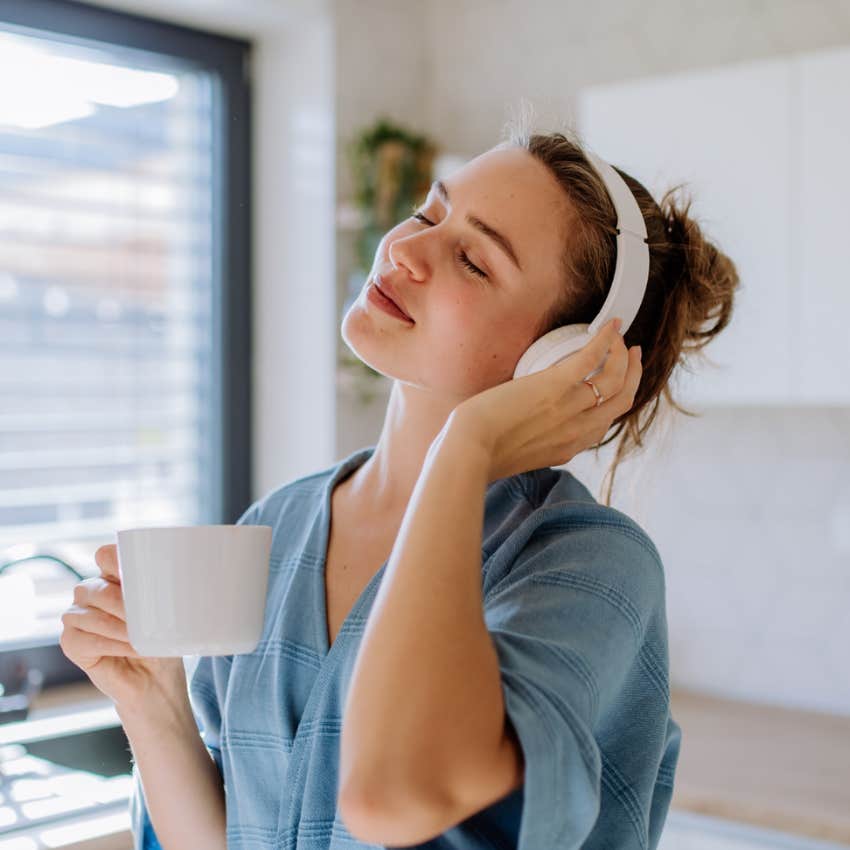14 Easy Ways To Feel A Tiny Bit Happier Each Day, According To Psychology
Happiness isn't all or nothing.
 João Rabelo | Canva
João Rabelo | Canva I’m now in a satisfying, healthy relationship with an incredible man — but I never thought I’d see the day. Six years ago, I was diagnosed with a severe dissociative disorder. If I were capable of feeling anything, I would’ve felt relief. It suddenly made so much sense: Why I sabotaged all my relationships. The reason I was always looking for a way out. How could I fake love, but not feel it?
Why, when I pictured my future, I pictured it alone. The diagnosis was the first step, but it was a long road to healing. I started an intensive therapy technique called EMDR, and I was single for years while I healed my trauma response, reset my nervous system, and returned to my body and emotions.
When I did finally start dating again, I decided: I’m not going to settle for anything less than an amazing connection with the right partner. Needless to say, things got pretty lonely sometimes.
It took all of my self-control not to end up with the wrong guy out of desperation — and that would’ve been understandable. Humans are hardwired to crave connection thanks to a little thing called oxytocin.
Oxytocin (often called the bonding hormone, the love hormone, or the cuddle hormone) is a neurochemical our brains make to encourage social bonding. Hugging, kissing, cuddling, and physical intimacy trigger its release. So does childbirth and breastfeeding.
While all people produce oxytocin, studies show that women need it more than men. When we don’t get enough of it, it can manifest as anxiety, depression, stress, a dysregulated nervous system, and an overwhelming urge to settle for any guy who gives you the slightest bit of affection.
Research even shows that oxytocin is one of the primary reasons women may struggle to leave abusive relationships. As a feminist, a neuroscience nerd, and a formerly dissociated woman who knows how healing the right relationship (or no relationship at all) can be, I am begging you: Please do not settle.
You can boost your oxytocin levels to feel a tiny bit happier each day, and I’m going to use scientific studies and clinical research to show you how.
Here are 14 easy ways to feel a tiny bit happier each day, according to psychology:
1. Book a massage or hair wash
A study from Alternative Therapies in Health and Medicine found that massage increases oxytocin and lowers adrenocorticotropin (a hormone that’s activated during fight-or-flight).
In other words, comforting touch from basically any human will trigger the bonding hormone — yes, even when they’re a stranger and you’re paying them. If you can’t afford a massage, go to a salon and get your hair washed. It typically costs less than $30, and a scalp massage will also stimulate the release of oxytocin.
2. Spend time with animals
 New Africa / Shutterstock
New Africa / Shutterstock
If you have a pet, you’re sitting on an oxytocin goldmine. A 2015 study found that merely making eye contact with your dog prompts a surge of oxytocin in both the animal and the owner. Similarly, cuddling with your pup, petting your cat, or scratching your guinea pig behind the ears also boosts oxytocin and lowers stress hormones.
Don’t have a pet? Volunteer at an animal shelter, offer to walk your neighbor’s dog, book a horseback riding session, or spend the afternoon at a petting zoo.
3. Hug someone for 20 seconds
As previously discussed, cuddling with a partner gets your oxytocin flowing — but so does non-romantic touch with other people.
While a few seconds of physical touch is sufficient (and a little less awkward), the bonding hormone peaks at around 20 seconds, so ask a close friend or family member for a long hug. Explain the science and tell them they’ll also benefit.
4. Soothe with heat
Your body releases oxytocin in response to warm temperatures, so saunas can be particularly beneficial. If you don’t have access to a sauna, a hot bath, a foot soak, a heated blanket, or a hot compress also does the trick.
5. Try EFT tapping
Emotional Freedom Technique (also known as EFT or tapping) is a practice in which you tap through nine meridian points along the body while focusing on difficult emotions or memories.
I know it sounds like new-age quackery, but studies show that it’s a hugely beneficial practice. In addition to relieving stress, anxiety, depression, pain, or trauma, it also boosts oxytocin.
6. Experiment with acupuncture or acupressure
Acupuncture is a traditional Chinese medicine practice in which thin needles stimulate nerves, muscles, and connective tissues at specific points on the body.
One study showed that acupuncture can ease the symptoms of autism due to its effects on oxytocin, while another showed that it can reduce pain during labor for similar reasons. As a result, it may also be an effective tool for minimizing loneliness.
If acupuncture is too expensive or needles freak you out, acupressure offers similar benefits. I have an acupressure mat that I use to encourage relaxation, ease muscle tension, boost circulation, and prompt the natural release of endorphins.
7. Take a group exercise class
Studies found greater oxytocin concentrations in people’s saliva after they engaged in physical activity. Exercise is great for increasing oxytocin — but exercising with other people is even better.
When you combine movement with group activities, the bonding hormone kicks into high gear. Joining a sports team, dance group, running club, or yoga class can boost oxytocin without a romantic relationship. You can also go for a walk with a friend.
8. Strengthen your spirituality
Research shows a link between spirituality and oxytocin. One study administered exogenous oxytocin to participants, who then reported a greater connection to their spirituality and more positive emotions during meditation.
But it works the other way around, too.
Participating in spiritual activities like loving-kindness meditations, yoga, prayer, sound baths, volunteer work, and community ceremonies all encourage healthy levels of oxytocin.
9. Share a meal with someone
Food sharing is related to high oxytocin levels in chimpanzees, and humans are no different.
We’re social creatures who evolved to share resources with our tribe, so food is more than just sustenance; It’s social glue.
Sharing a meal with someone at a restaurant is a low-effort way to boost connection. Having a friend over for a home-cooked meal is even better. When you cook alongside another person, you’re combining the benefits of food sharing, collaboration, and social connection into one bond-building activity.
10. Listen to music
 Halfpoint / Shutterstock
Halfpoint / Shutterstock
If you’ve ever been to a particularly great concert, you already understand the group-synchronizing effects of music. The crowd seems to move as one, and the air in the venue feels electric.
But due to its impact on the limbic system, music can prompt a sense of interconnectivity even if you’re listening to it alone. When researchers had postoperative patients listen to music through headphones, they found increased oxytocin and higher levels of relaxation.
The next time you’re feeling lonely, blast one of your favorite songs in your home or car. Even better, dance to it or go for a walk while listening to compound the benefits of music and physical movement.
11. Sing in a group or play in a band
Humans created the first instruments over 40,000 years ago. Communal singing, chanting, drumming, and dancing have played a vital role in the formation of our social bonds, so it’s no wonder that oxytocin skyrockets when we create music together.
If you play an instrument, start a band with your friends. If you like singing, join a choir or chorus. You don’t have to be good at it; any kind of group singing elevates oxytocin, so even drunk karaoke with your friends will do.
12. Supplement with magnesium
Magnesium is required for over 300 enzymatic functions in the body, including oxytocin’s ability to bind to its receptors — but over half of Americans are deficient in it.
Foods that are rich in magnesium include dark chocolate, avocados, nuts, seeds, leafy greens, legumes, whole grains, and fruit.
You can also take magnesium supplements orally, but I prefer to use a topical spray. It absorbs through your skin to promote relaxation, muscle recovery, deep sleep, stress relief, and oxytocin support.
13. Eat probiotic-rich foods
Oxytocin levels are directly linked to your microbiome, which is the community of microbes that live in your gut. Lactobacillus reuteri (a type of beneficial bacteria) upregulates oxytocin, so when you don’t have enough of it, you may experience higher levels of depression, anxiety, or loneliness.
Probiotic-rich foods that contain Lactobacillus reuteri include yogurt, kefir, sourdough bread, and fermented vegetables like kimchi and homemade sauerkraut. You can also take it as a supplement.
14. Bake sweet-potato brownies
I recently started making sweet potato brownies for hormone support during my luteal phase (10/10 would recommend), but they’re also great for healthy oxytocin levels.
Dark chocolate, almond flour, and sweet potatoes are all rich in oxytocin-supporting magnesium. So is maple syrup, which I typically use in place of sugar. Finally, baking — especially baking for other people — also elevates oxytocin.
I promise you can’t taste the sweet potatoes, but if the thought of root vegetables in your dessert grosses you out, you can also opt for this chocolate cake, which is aptly named.
And when chocolate simply won’t cut it, self-pleasure also works. (I guess that’s technically 15, but what can I say? I’m a girl’s girl.)
Maria Cassano is a writer, editor, and journalist whose work has appeared on NBC, Bustle, CNN, The Daily Beast, Food & Wine, and Allure, among others.

